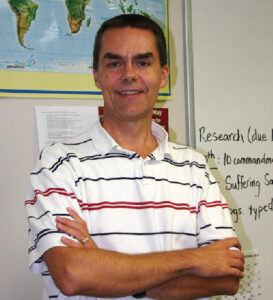Two are better than one, because they have a good return for their labor…
–Ecclesiastes 4:9
This Bible verse–nearly 3,000 years old–speaks to the value of friendships and partnerships in life.
Almost 400 years ago–in a gloomy 1623 Christmas season–the dean of London’s famous St. Paul’s cathedral was struggling to minister in the midst of an epidemic. Daily, church bells rang to mark the death of another Londoner, and the minister, John Donne, for several days was himself ill and believed he would die. From what he thought was his deathbed, Donne penned what has become a famous and profound passage:
No man is an island, Entire of itself; Every man is a piece of the continent, A part of the main. (…) Any man’s death diminishes me, Because I am involved in mankind. And therefore never send to know for whom the bell tolls; It tolls for thee.
These thoughts of friendship, death, and our connectedness to one another have been on my mind since the news of the passing of a dear friend, Terrence “Terry” Racher, on Ash Wednesday, February 17, 2021.
Ash Wednesday, which begins the forty-day Christian period of repentance and reflection leading to Easter, is a solemn time. Many times, as the priest applies the smudge of ashes to the believer’s forehead, he intones, “remember that you are dust, and to dust you shall return.”
While reflecting on Terry’s death and life, I realize afresh what an incredibly joyful, exuberant, life-filled person he was. You didn’t just “meet” Terry Racher. You “experienced” him.
Born in Canada in 1936, he eventually moved south to the US, became a citizen, and embarked on a remarkable life journey. I used to joke with him, that he had the longest and most incredible resume of anyone I knew.
His jobs included US Navy sailor patrolling the Taiwan Strait early in the Cold War, butler to a millionaire, Christian pastor, work stint on the Micronesian islands of Guam and Saipan in the Pacific, and serviceman based in an Intercontinental Ballistic Missile (ICBM) silo in the Midwest.
That is where he was in October 1962, during the Cuban Missile Crisis. He explained that his crew had been told to take every step to launch their missile against the USSR, except the final step. “The world will never know how close we were to WWIII,” he told me several times.
I had the blessing of meeting Terry while he was in the “teacher iteration” of his amazing career and life. It was September 1990, and was starting my second year teaching in Hsinchu, Taiwan.
Terry and his wife had been on the island for several years by then so, among us expatriates, they were the pros and I was the newbie. We were all on staff at the Presbyterian Bible College and Terry went out of his way to welcome me and make me feel part of the team.
He and his wife lived in a house that had been built for Canadian missionaries, so even though we were in East Asia, their home–where I was a frequent guest–felt like an American home, complete with coffee maker, full oven, and–unbelievably–a wood stove.
Countless times, as a young, homesick, culture-shocked man, they welcomed me into their home with a cup of coffee, sandwiches, stories, and big smiles. And the music! Terry was one of those rare folks who could pick up a guitar and play almost any song by ear and memory.
At that time, the only English-language church services available in Hsinchu City were an hour or more away–in Taipei to the north, or Taichung to the south. (We had not heard of the internet in 1990.) An engineer from Virginia based in Hsinchu wanted to establish an English-speaking church for non-Chinese speakers, so he approached four missionaries in the city to help create such. Those missionaries were already busy with their own ministries, but they agreed to rotate by providing one English sermon a month.
The four missionary couples, despite their different backgrounds, modeled a beautiful picture of Christian unity: USA Presbyterian, Canadian Presbyterian, Lutheran Brethren, and the Rachers who were Southern Baptist. The new congregation did not even have a name when it started; the first bulletin just called it “Hsinchu English Service.”
Terry graciously prepared and delivered one English sermon per month to make the rotation work, and because he had a gift with music, he often played the guitar and helped lead worship. Everyone involved in the new church did so as a cheerful volunteer.
When we launched the church on the first Sunday of October in 1990, we did not know if it would survive till the end of the month, let alone to the end of the year or the next summer. After a few weeks, the congregation picked a name: Hsinchu International Church (HIC). Being an international church, congregational turn-over was high, but as some members left the area, God always brought new folks in to keep the ministry going.
None of the original founders of HIC are still there, but as an example of God’s faithfulness, the church continues to meet, worship Christ, and teach the Bible after thirty years. Three decades and counting of HIC ministry is one of the countless examples of Terry’s living legacy.
Then came early 1991, when Terry, a mutual friend from Austria, and I met in Terry’s living room and dreamed up a plan that became the adventure of a lifetime.
Stay tuned. More about that in Part II.

– Scott Dreyer

